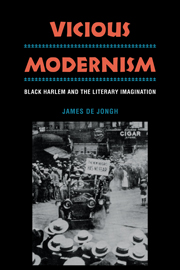Book contents
- Frontmatter
- Contents
- Acknowledgments
- Introduction: Vicious Modernism
- I The Legendary Capital: The 1920s and 1930s
- 1 The Legendary Capital
- 2 City of Refuge
- 3 Crossing the Color Line
- 4 Me revoici, Harlem
- II The Emerging Ghetto: The 1940s and 1950s
- III The Inner City: The 1960s and 1970s
- Epilogue: Black Harlem and the Literary Imagination
- Appendix 1 A Checklist of Black Harlem in Poetry
- Appendix 2 A Checklist of Black Harlem in Novels
- Notes
- Index
3 - Crossing the Color Line
Published online by Cambridge University Press: 05 February 2012
- Frontmatter
- Contents
- Acknowledgments
- Introduction: Vicious Modernism
- I The Legendary Capital: The 1920s and 1930s
- 1 The Legendary Capital
- 2 City of Refuge
- 3 Crossing the Color Line
- 4 Me revoici, Harlem
- II The Emerging Ghetto: The 1940s and 1950s
- III The Inner City: The 1960s and 1970s
- Epilogue: Black Harlem and the Literary Imagination
- Appendix 1 A Checklist of Black Harlem in Poetry
- Appendix 2 A Checklist of Black Harlem in Novels
- Notes
- Index
Summary
In the decade before 1925, black writers had tackled the literary theme of Harlem in poetry and short fiction, with little visibility beyond the periodicals of the black community. Non-blacks, even those who specialized in writing popular fiction and poetry about blacks, had ignored Harlem as a literary theme, but the commercial success of the Harlem issue of Survey Graphic and The New Negro, followed almost immediately by the best-seller status of Nigger Heaven, and later of Home to Harlem, demonstrated the popular appetite for images of Harlem. Harlem's currency and sensational status as a cultural symbol made it an inviting target for writers of all races, and, for nearly a decade after 1926, imaginative literature about black Harlem became inescapable. Many of the poets and short-story writers published in The New Negro attempted longer works of fiction; several new black novelists began to cultivate the interest in Harlem; and in less than a decade some twenty novels by African-American writers were published, most of them set, in whole or in part, in Harlem. Harlem episodes became a not uncommon feature of works concerned neither with Harlem nor with black life by a series of white novelists, and a cosmopolitan array of non-black poets began interpreting the implications of Harlem's vitality.
- Type
- Chapter
- Information
- Vicious ModernismBlack Harlem and the Literary Imagination, pp. 33 - 47Publisher: Cambridge University PressPrint publication year: 1990



